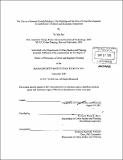| dc.contributor.advisor | Diane E. Davis. | en_US |
| dc.contributor.author | Joo, Yu Min | en_US |
| dc.contributor.other | Massachusetts Institute of Technology. Dept. of Urban Studies and Planning. | en_US |
| dc.date.accessioned | 2012-01-12T19:28:09Z | |
| dc.date.available | 2012-01-12T19:28:09Z | |
| dc.date.copyright | 2011 | en_US |
| dc.date.issued | 2011 | en_US |
| dc.identifier.uri | http://hdl.handle.net/1721.1/68443 | |
| dc.description | Thesis (Ph. D.)--Massachusetts Institute of Technology, Dept. of Urban Studies and Planning, 2011. | en_US |
| dc.description | Cataloged from PDF version of thesis. | en_US |
| dc.description | Includes bibliographical references (p. 201-214). | en_US |
| dc.description.abstract | This dissertation bridges the fields of international development and urban studies to examine South Korea's city building and urban development processes, arguing that the interaction between urban and industrial policies has both followed and produced the country's astonishing macroeconomic development successes. The study starts by raising the question of how a Third- World city, Seoul, which served as a minor metropolis in a primarily rural country as late as 1970, rapidly became a modern megalopolis and global front-runner in terms of ambitious and pioneering urban investments. Although South Korea's successful industrialization could be a short answer to this question, the capital city's predominant growth becomes rather puzzling when considering that South Korea, in contrast to the Latin American cases, initially developed its major industrialization and spatial development policies to support regional development and decentralization instead of promoting urban concentration in the capital city. To explain this puzzle, I examine South Korea's key spatial development policies and city building projects over the course of its economic development trajectories, from the 1960s to the 2000s. In the process of re-examining South Korea's modern economic development history with an emphasis on space, I found that the South Korean state worked actively to develop synergies between spatial and economic development, thus fortifying its role as both an industrial and urban developmental state. At consecutive stages since the late 1960s, the South Korean state deployed a disciplinary, forward-looking, set of policies targeted toward creating synergy between urban investments and macroeconomic priorities, even as it worked hard to accommodate citizen concerns about consumption, property rights, and democratization. With an eye to both political stability and economic growth, the South Korean state ended up crafting a set of spatial policies that ended up produced novel inter- and intra-urban development patterns that stood in contrast to those pursued in many other countries of the global South. Seoul's developmental gains, both urban and macroeconomic, are thus explained as an outcome of a strong state's commitment to connecting spatial and economic priorities, and to its capacity to guide these synergies over time and across various territorial scales. | en_US |
| dc.description.statementofresponsibility | by Yu Min Joo. | en_US |
| dc.format.extent | 214 p. | en_US |
| dc.language.iso | eng | en_US |
| dc.publisher | Massachusetts Institute of Technology | en_US |
| dc.rights | M.I.T. theses are protected by
copyright. They may be viewed from this source for any purpose, but
reproduction or distribution in any format is prohibited without written
permission. See provided URL for inquiries about permission. | en_US |
| dc.rights.uri | http://dspace.mit.edu/handle/1721.1/7582 | en_US |
| dc.subject | Urban Studies and Planning. | en_US |
| dc.title | The City as a national growth machine : city-building and the role of urban development in South Korea's political and economic transitions | en_US |
| dc.title.alternative | City-building and the role of urban development in South Korea's political and economic transitions | en_US |
| dc.type | Thesis | en_US |
| dc.description.degree | Ph.D. | en_US |
| dc.contributor.department | Massachusetts Institute of Technology. Department of Urban Studies and Planning | |
| dc.identifier.oclc | 769003828 | en_US |
